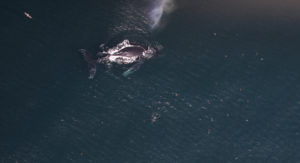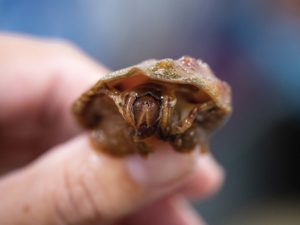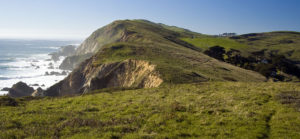Basking sharks can be over 30 feet long and are characterized by their enormous gill rakers and three-foot tall dorsal fins. But these mysterious, massive, filter-feeding cousins of the great white shark aren’t just a scientific curiosity – they also seem to be vanishing from California and the rest of the Eastern North Pacific.
The National Oceanic and Atmospheric Administration conducted aerial surveys from 1962-2004 to monitor populations of commercially valuable fish such as sardines. The aerial surveys proved to be a valuable historic record for basking shark sightings, which are easily large enough to be spotted from the air.
Pilots reported their sightings to NOAA every year, and researchers have found that sightings decreased dramatically over the four decades of the survey.
“The group size has declined, along with the decline in sightings,” said Alexandra McInturf, a postdoctoral scholar at Oregon State University and lead author on a new basking shark paper in the journal Frontiers in Marine Science. McInturf wrote the paper as a PhD candidate at UC Davis. “Prior to the 2000s, you could see up to 500 individuals in a group … and then after the 2000s, we were only seeing up to 10.”
Basking sharks were listed as globally endangered by the International Union for Conservation of Nature in 2019, but the decline has taken place largely out of public view.
“They’re big charismatic animals, and they look so weird,” McInturf said. “They’re not going to hurt you, you know, they are basically whales, but the shark version. I’m surprised that people haven’t latched on to them sooner.”

“Basking sharks are generally filter feeders, and their teeth are really not much bigger than your little pinky fingernail,” said David Ebert, the program director for the Pacific Shark Research Center at Moss Landing Marine Laboratories and one of the paper’s co-authors. “They basically strain water – they swim with their mouths open …Their gill rakers are basically set up to be like big sieves.”
Though they’re spotted at the surface, basking sharks can spend up to 90 percent of their time underwater, Ebert said. They often surface to feed on copepods, a type of zooplankton that NOAA fisheries biologist Heidi Dewar, also one of the paper’s coauthors, describes as “the cows of the sea” for their role as grazers of the ocean’s photosynthesizing primary producers.
Basking sharks also feed on other small prey items such as fish eggs. Despite their small prey, they grow huge, making them the second-largest fish in the ocean behind only the whale shark. They are known to be long-distance migrants that are generally found at depths of 300 to 500 meters, though they are capable of diving much deeper.
Basking sharks often feed in areas of the ocean known as fronts, Dewar explained, which are subject to “physical forcing mechanisms that act to concentrate prey.” These food-packed fronts can occur both above and below the surface of the water.
For a separate study published in 2018, Dewar and others tagged three basking sharks off the California coast, which they then tracked around the Pacific, including waters near Hawaii and Baja California. While the sharks tend to be seen off the California coast from spring until fall, they remain largely a mystery in terms of their habits, distribution, and population size.
“Very little is known about them,” McInturf said. “They do these kind of booms and busts, where there’s a lot of variability in when they show up and how many come at a certain time.”
“We don’t even know where they have babies,” Dewar said. “There’s so much that’s not known.”

Even estimating the age of the few basking sharks that are seen is an impossible task. Age is often estimated by counting the bands on a shark’s vertebrae and “for some species, that does tend to work, where the bands tend to be annual, like you count bands on a tree,” Ebert said. “Basking sharks have beautiful bands to count, but it turned out the bands are not equated to age. We have absolutely no idea how old the sharks get. Anything you see is just a pie in the sky guess because we just don’t know.”
Learning more about this species is extremely difficult because of how rarely they are spotted.
Researchers predict that a mix of factors – among them the residual effects of historic basking shark overfishing – is to blame for the drop in sightings in recent years off the California coast.
During the 20th century, basking sharks were targeted by fisheries in both the Pacific and Atlantic Oceans for their highly profitable oily livers and large fins.
“In Canada, it was more this eradication program that they had because the sharks would swim into the salmon nets and destroy them,” Dewar said. “So they designed these vessels that basically had a big knife on the front of them and they would just ram basking sharks to protect their fishing nets.”
This culling practice and the basking shark fisheries of the Eastern North Pacific ended in the mid-to-late 1900s, and today, basking sharks are protected within 200 miles of the coast of the United States and Canada, and by the United Nations Convention on International Trade in Endangered Species beyond that.
“It’s a long lived species,” Dewar said. “It takes them a long time to recover from overexploitation, and they likely don’t have very many young.”
Fishing and culling of basking sharks began decades before aerial surveys indicated a potential decline in basking shark populations, and “this is likely because of a lag due to the long lifespan and late maturity of these animals,” McInturf wrote in an email. “It’s really hard to say why this effect wasn’t immediately apparent.”
Now, researchers hope for greater awareness and monitoring for this fish that is so rarely seen. McInturf has spent three summers studying basking sharks in Ireland, and in that time, she has only seen them once. “That is common,” McInturf said. “And it’s really unfortunate. I call them shark droughts. And they happen a lot. It’s really hard to predict where they’re going to be and when they’re going to show up.”

For researchers to look for the sharks, they also have to be in touch with people that are regularly on the water. “You’ve got to get a tip like, ‘Hey, we’re seeing them off Monterey, Santa Cruz or someplace,’ and you’ve got to get out there and see if you can find it and put a tag on it,” Ebert said.
“I grew up around the Monterey area, and I’ve been on the water since I was a young kid,” he added. “And you’d see them, but it wasn’t something you’d think like, ‘Oh, who am I going to call?’”
Since 2010, the Pacific Shark Research Center, NOAA, and other collaborators in Canada, the United States, and Mexico have helped to generate the Spot a Basking Shark citizen science project that allows members of the public to submit sightings of basking sharks through an online portal.
“The people on the water deserve a lot of respect for the stuff that they know, and we rely really heavily on them,” McInturf said.
Dewar also mentioned that the public could call and report sightings by calling the Southwest Fisheries Science Center at (858) 546-7000, and she urged folks to take photos and to give basking sharks space when they are spotted, as they are susceptible to boat strikes.
For a species that is so rarely seen, staying connected with people who fish, whale-watchers, and the public as a whole is a key part of the process of monitoring this species.
“People have lost track of the fact that basking sharks used to occur in really high numbers off of California,” Dewar said. “The sightings would have been sporadic, but they were here – they were a part of the flora and fauna of California. And people have lost track of that. I think that that concept is really important as we deal with the impacts of climate change. Our normal isn’t necessarily unimpacted.”





